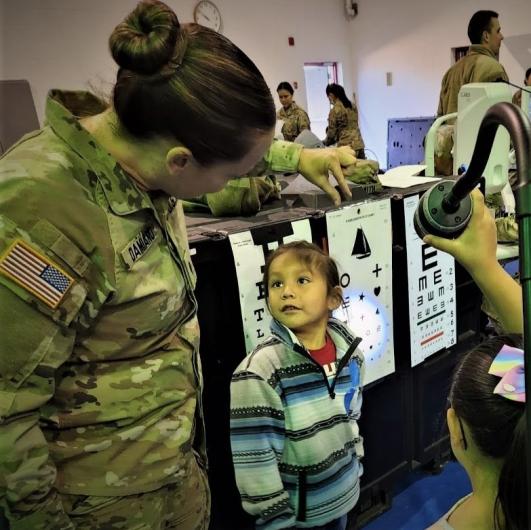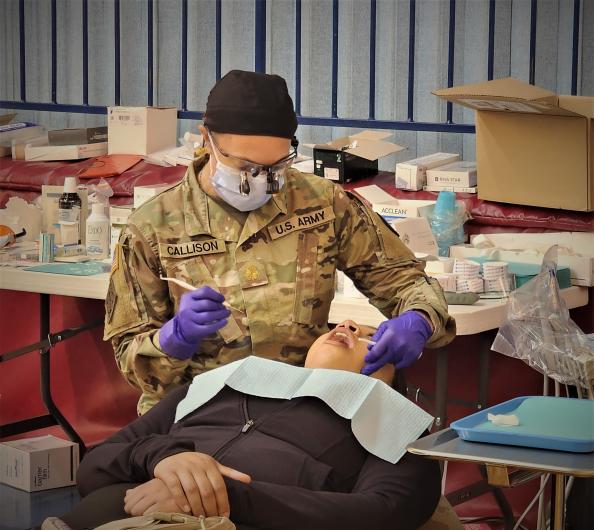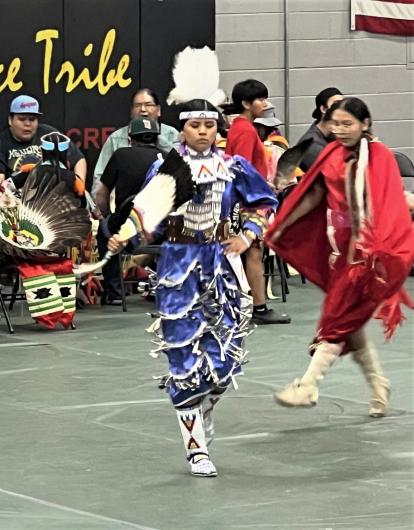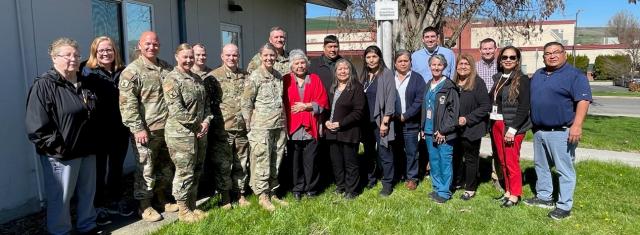You are viewing ARCHIVED content published online before January 20, 2025. Please note that this content is NOT UPDATED, and links may not work. Additionally, any previously issued diversity, equity, inclusion or gender-related guidance on this webpage should be considered rescinded. For current information, visit https://www.blm.gov/blog.
Military Appreciation: Building Partnerships in Idaho
As we observe Military Appreciation Month, Air Force Maj. Megan Kiska explains the value in building partnerships.
What do an Idaho Air National Guard mission protocol officer and a BLM Idaho administrative assistant for support services have in common? You might be surprised.

When Megan Kiska walks the corridors of the Bureau of Land Management Idaho State Office, you wouldn’t know in addition to her mission of protecting the land for future generations, she is also a major in the Idaho National Guard building relationships with local Tribal communities.
This May, Air Force Maj. Megan Kiska, deployed for two weeks with the Idaho Air National Guard during their Innovative Readiness Training (IRT), with the goal of providing annual medical care to the Tribal Nations of Nez Perce (Nimiipuu) and Shoshone-Paiute (Sho- Pai).
While most Tribal members receive Tribal medical coverage, “some family members and locals on the reservation may not receive health coverage,” says Megan. “The IRT is a collaborative program that leverages military and community resources to provide cost savings for participants and hands-on optical, dental, pharmaceutical and health education services for members of the Tribal community who may need to travel extended distances to the closest medical facility.”

According to Megan, who planned travel and developed presentations for distinguished federal, state, Tribal and military visitors during the IRT, military medics performed over 1,800 procedures assessed at a $234,359 fair market value in Lapwai, Idaho, and Duck Valley, Nevada.
“Medics pulled molars, performed cleanings, provided glasses and even found blood clots, which saved lives,” she says.

A logistics officer by trade, Megan explains how the IRT provides real world logistics training, keeps helicopter personnel current with transportation/aviation qualifications, brings Army and Air Force medics together with Tribal health professionals, and provides a chance for Idaho and Nevada National Guard units to partner, and provides an opportunity to medical professionals to provide real-world training to improve readiness and survivability in complex contingency environments while providing key services for American communities using joint training operations.
Medical IRTs build trust at the local, state, and federal level. “We partner with members from the Tribes during the health fair which is another way to help the community. They offer educational information on suicide prevention, alcoholism, sexual education, and the Head Start program. We also work with other non-profit organizations to provide specialized medical care and personnel, that we may be unable to provide.”

In addition to the recent IRT, Idaho National Guard also trains at the Orchard Combat Training Center (OCTC), which is located 18 miles south of Boise, Idaho, at the Morley Nelson Snake River Birds of Prey National Conservation Area on BLM public lands. Megan works with environmental teams in protected Tribal areas and on BLM public lands, which is partially how she became familiar with the agency. She was also exposed to the BLM during required National Guard wildfire incident qualification training where guardsmen train to receive their Incident Qualification Card, commonly known as a Red Card. They work with the BLM, Idaho Department of Lands, U.S. Forest Service, and the Idaho Office of Emergency Management serving the state to fight wildfires. “The BLM Hotshots often lead the fire teams that include National Guard members.”
Megan, who had been an Air Force active duty, reserve, and guard member, believes that being part of the military can help benefit everyone in the community, since the National Guard can provide fire and emergency response, helicopter rescue teams, medical, civil engineering, and cyber response for Tribal Nations, and being in the National Guard keeps the services and expertise within state.

According to Megan, every military experience is an opportunity for relationship building and skills learned during training and partnership events and easily transferable from the military to the civilian realm.
She is an Idaho transplant who has lived here for 10 years and moved to Idaho because of her “passion for outdoor activities and perfect seasons.” Her favorite BLM areas are Salmon, Cottonwood, and Coeur d’Alene. She and her family are “big hikers, big outdoorsy people who like to snowshoe, fish, golf and ride 4-wheelers.” Her children are on the ski team at Bogus Basin and as a family, they are “big water people who like to float the Boise River and boat at C.J. Strike Reservoir.”
** More than 2,000 veterans work at the Bureau of Land Management. We are deeply grateful for their sacrifices, dedication, and courage.
** If you know a local veteran who we should highlight, let us know.
Jennifer Hayes, Public Affairs Specialist
Related Stories
- Protecting the community: Challis Field Office takes steps to ensure a fire resilient landscape
- Twin Falls District Engineer Eddie Sanchez – seasonal wildland firefighter to engineer
- Coeur d’Alene District and Nez Perce Tribe Strengthen Community Through Partnership
- Growing a Culture of Co-stewardship with Betsy Chapoose of the Ute Indian Tribe
- Secretary Deb Haaland visits with Ancestral Lands Conservation Corps crew working to stabilize Lowry Pueblo
